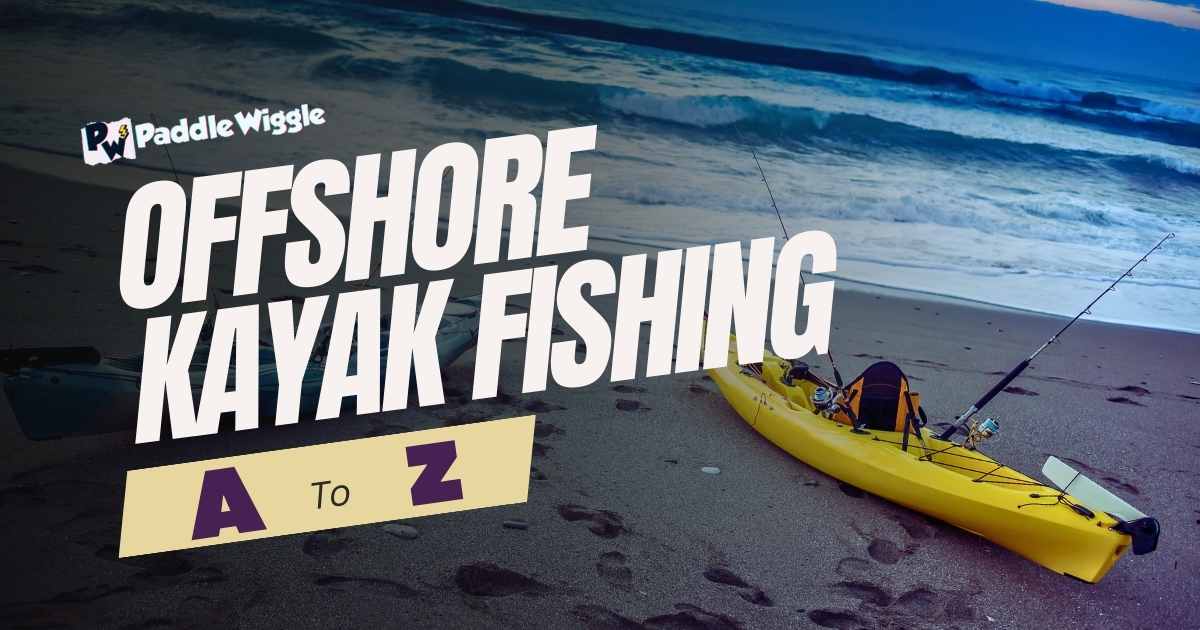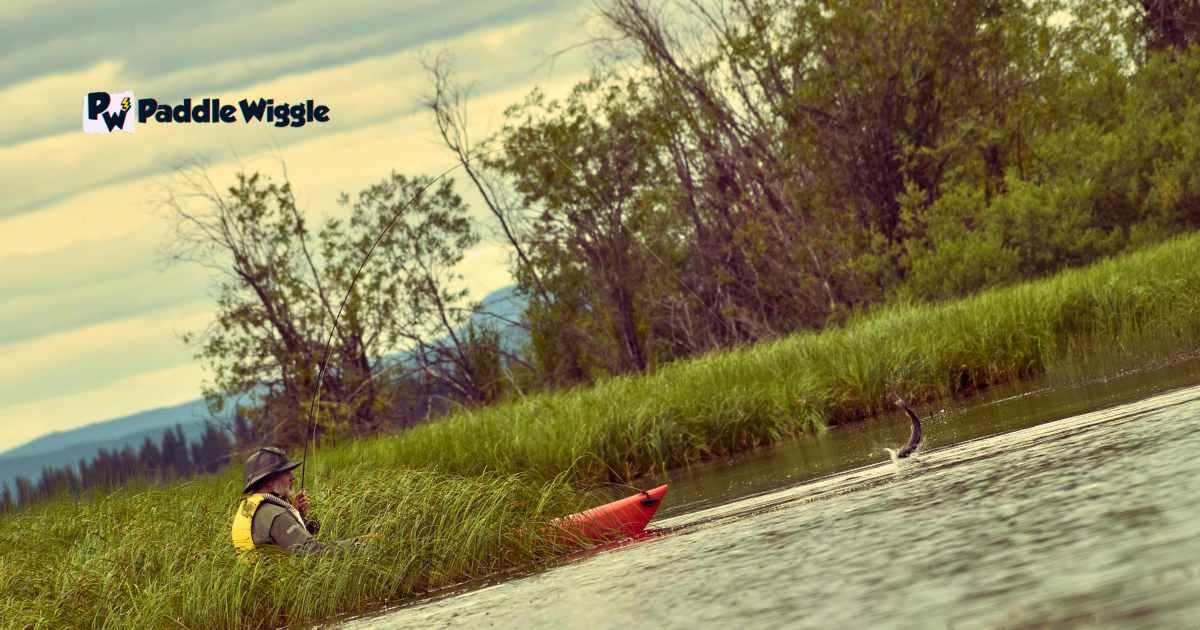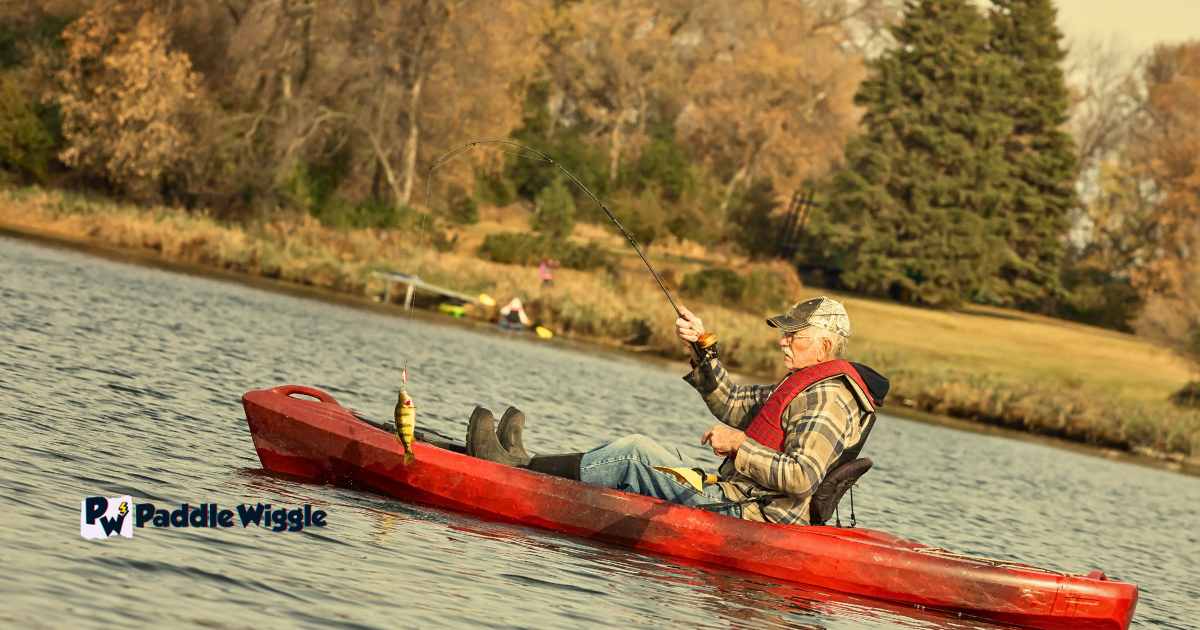If you’re in search of an exciting and one-of-a-kind fishing adventure, then offshore kayak fishing might be your answer! It’s a thrilling experience that brings you incredibly close to nature, with the ocean all around you, the wind in your face, and the mystery of what’s below the water’s surface.
But here’s the thing – offshore kayak fishing isn’t just about grabbing a kayak and heading out to sea. It requires some serious knowledge, preparation, and knowing the dos and don’ts to ensure your safety and a successful fishing trip.
In this guide, we’re diving headfirst into the world of offshore kayak fishing. We’ll give you all the tips you need, recommend the right gear, explain safety precautions, and share strategies to make your offshore fishing journey enjoyable and secure.
Let’s set sail!
Contents

Offshore Kayak Fishing: Do’s And Don’ts
Offshore kayak fishing is an exciting adventure, but it has challenges. To enjoy it safely and successfully, you need to know what to do and what not to do. Beginners often make mistakes, so having patience and determination is important.
Here are dos and don’ts to help you navigate offshore kayak fishing:
7 Dos to Follow When Kayak Fishing Offshore
Fishing from a kayak out in the open water can be super exciting and satisfying, but it needs some good thinking and getting ready. Here are seven important tips to help you have the best time while offshore kayak fishing.
Here are seven do’s to follow:
#1. Master Kayak Control
Advanced offshore kayak anglers excel in the art of kayak control. They possess the skills and knowledge necessary to navigate challenging conditions with ease. These folks are really good at using their paddles to go fast and steer well. Even when the water is tricky with strong currents, gusty winds, or rough waves, they always know how to handle their kayak. This skill doesn’t just keep them safe, but it also helps them get to the best fishing spots, where they have a better chance of catching big fish.
#2. Use Advanced Fishing Techniques


To catch elusive and powerful offshore species, advanced anglers go beyond the basics. They delve into advanced fishing techniques that require precision and expertise. Deep-dropping is a way to catch deep-sea fish like tilefish and grouper. It needs special gear and knowing how deep the ocean is. Slow trolling, often used for fish like king mackerel and tuna, needs you to control the bait and lures very carefully at different depths and speeds. Kite fishing, used for fish like sailfish that swim near the surface, means you hang baits on the water with kites. These methods are a bit tough and challenge anglers who like kayak fishing to get better at what they do.
#3. Stay Informed About Fish Behavior
Experienced offshore kayak anglers are avid students of the sea. They constantly seek to deepen their understanding of fish behavior and migration patterns. They can predict where and when to find the fish they want by knowing when these fish typically move, what they like to eat, and where they like to be. This knowledge is invaluable for planning successful offshore excursions. They may consult scientific studies, local experts, and fellow anglers to gather insights and make informed decisions about when and where to venture offshore.
#4. Customize Your Kayak
Anglers who go fishing far out in the ocean in kayaks are experts. They understand that everyone is different, so they change their kayaks to fit their own needs. They add things like extra places to hold fishing rods, special storage, and advanced gadgets like fishfinders and map systems. These enhancements are designed to optimize their kayak’s performance for offshore conditions. They adjust their gear to make a fishing setup that works best for them, making it super efficient and useful.
#5. Learn Advanced Knots
When you’re going after big, strong fish in the deep sea, using really strong knots is super important. Experienced fishermen spend time learning and practicing special knots that can hold heavy fishing gear, leaders, and swivels securely. Strong knots are a big deal because they help you catch and handle powerful fish. Some important knots for expert kayak fishermen include the Bimini Twist, the Double Uni Knot, and the Loop-to-Loop Connection.
#6. Network with Other Advanced Anglers
Advanced anglers recognize the value of networking within their niche community. They really want to make friends with other experienced kayak anglers. These friends can tell them about what they’ve learned and the best places to fish in the deep sea. Having these friends is like having a useful source of information about the newest methods, equipment, and what’s happening in the area. They can make these friends by talking to people online, on social media, or by joining local fishing clubs. Making friends this way lets them learn from a lot of people who know a whole bunch about fishing.
#7. Contribute to Conservation
With advanced skills come advanced responsibilities. People who are really good at fishing from kayaks in the open sea know it’s vital to fish in a way that doesn’t harm the environment and the sea creatures. They help by joining tagging programs, supporting science studies, and telling others to fish responsibly. By doing all this, they make sure the oceans and the animals in them are safe so that kids in the future can enjoy fishing just like they did.
Offshore Kayak Fishing: 3 Don’ts To Avoid


Offshore kayak fishing can be an exhilarating and rewarding experience, but it’s important to keep in mind a few key things to ensure your safety and success. Let’s dive in!
#1. Avoid going too far offshore without proper navigation equipment
When heading out on your kayak fishing trip, it’s essential to have the right tools for navigation. Going too far offshore without proper equipment can lead to getting lost or disoriented, which is not only dangerous but can also ruin your entire fishing trip. Invest in a reliable GPS device or a nautical chart that will help you stay on track and find your way back safely.
#2. Don’t forget to check the weather conditions before heading out
The weather plays a significant role in offshore kayak fishing. Before embarking on your adventure, always check the weather forecast. Stormy or rough conditions can make kayaking challenging and unsafe. High winds and large waves can capsize your kayak or push you off course. It’s better to postpone your trip if the weather doesn’t look favorable.
#3. Avoid using live bait that is too large for the fish you are targeting
Using live bait is an effective strategy for catching fish while offshore kayak fishing. However, it’s crucial to choose bait that is appropriate for the size of fish you are targeting. Using bait that is too large may result in fewer bites or even scare away smaller fish altogether.
15 Tips for Successful Offshore Kayak Fishing
So, you’ve decided to take your kayak fishing adventures offshore. That’s awesome! Offshore kayak fishing can be an exhilarating and rewarding experience, but it also requires some extra preparation and know-how. To help you make the most of your offshore excursions, here are fifteen tips to keep in mind:
Tip #1: Plan for Long Trips
Planning is crucial. To ensure a successful and enjoyable experience, there are several key factors you should consider.
Pack enough supplies
When embarking on a long trip, it’s essential to pack enough supplies to sustain yourself throughout the journey. Make sure to bring an ample amount of food and water to keep yourself hydrated and nourished. Remember emergency equipment such as a first aid kit, signaling devices, and a spare paddle in case of any unforeseen circumstances.
Research potential fishing locations beforehand
Before you go kayak fishing, spend some time looking up good fishing spots. Find places where there are lots of fish and where it’s good for kayaking. If you do your research, you’ll have a better chance of catching a lot of fish.
Tip #2: Create a float plan
A float plan is like a roadmap for your trip. This info has important stuff like where you’re going, when you plan to be back, and who to call if there’s a problem while you’re on the water. It’s super important to tell a friend or family member about it just in case something goes wrong. This way, if you don’t return within the expected timeframe, someone will know where to look for you.
Practice safety measures
Safety should always be a top priority when engaging in offshore kayak fishing. Wear a personal flotation device (PFD) or life jacket at all times while on the water.
Deploy Drift Anchors
To make sure your kayak goes where you want when fishing in the open sea, you should use drift anchors. These anchors keep you in the right fishing spots and improve your chances of catching fish. Let’s dive into how drift anchors can enhance your offshore kayak fishing experience.
Tip #3: Control Your Kayak’s Drift Speed and Direction
When you’re in the open water, the currents and winds can push your kayak away from where you want to fish. This can be not very pleasant because it means you can’t fish as much. But if you use a drift anchor, you can slow down or stop your kayak from moving so you can fish in one spot for longer.
Using a drift anchor involves attaching it to a line and lowering it into the water at the bow or stern of your kayak. The drag created by the anchor helps counteract the forces pushing your kayak off course. By adjusting the length of the line, you can control both the speed and direction of your drift. Shortening the line will reduce drift speed while lengthening it will increase it.
Tip #4: Stay Within Desired Fishing Areas
One of the key benefits of using a drift anchor is that it enables you to stay within specific fishing areas. When you want to catch specific fish or fish in the best spots, it’s really important to stay in one place. If you don’t have an anchor, strong currents can push you away from the good fishing spots, and it’s hard to get back to them.
Wire Leaders
Now that you know how to use drift anchors, let’s talk about another important thing in open-sea kayak fishing: wire leaders. These are useful to stop fish with sharp teeth or gills from breaking your fishing line. Using wire leaders can increase your chances of landing larger game fish.
When you’re out on the open water, battling waves and wind, it’s important to have a strong and durable line that can withstand the powerful forces at play. This is where wire leaders come into play. They are made from sturdy materials such as stainless steel or titanium, which provide excellent resistance against abrasion and cutting.
Tip #5: Prevent Fish from Cutting Through Your Line
A big problem when fishing in the open sea is catching fish with sharp teeth or gill plates, like kingfish and others. They can easily cut through regular fishing lines, like monofilament or fluorocarbon, which can leave you without any fish and feeling let down.
When you put a wire leader between your fishing line and the bait or lure, it’s like adding armor. The strong wire stops the fish’s sharp teeth from cutting your line and getting away with your catch.
Tip #6: Increase Chances of Landing Larger Game Fish
Using wire leaders not only helps prevent lost fish but also increases your chances of landing larger game fish. When targeting big predators like kingfish or barracuda, they often put up a fierce fight when hooked. Their powerful runs and acrobatic jumps can put immense strain on your tackle.
Live Bait Well
To ensure a successful offshore kayak fishing trip, it’s crucial to have a live bait well on board. This useful feature keeps your live bait fresh and easy to reach during your long trips on the water.
Having a live bait well is great because it lets you use live bait to attract big, hungry fish like mahi mahi. These fish are attracted to the live bait’s movement and smell, so the live bait well is really important for catching them.
Here are some key points to consider when using a live bait well:
Tip #7: Keep Live Bait Fresh and Accessible
A live bait well is like a special place to keep your bait alive and well. It’s usually a tank with moving water that makes sure there’s enough oxygen for the baitfish to stay healthy.
When you keep your live bait fresh and easy to reach, you can grab them quickly when you need them. This saves time because you don’t have to look for new bait. You can then concentrate on fishing instead of always worrying about finding fresh bait.
Tip #8: Attract Predatory Fish
Predatory fish are drawn to the wiggling and vibrations of live baitfish in the water. If you keep lots of live bait in your kayak’s well, you improve your chances of getting these big fish to come to you.
When big fish see or feel lively prey around, they’re more likely to bite your hook, giving you a chance to catch impressive fish. Live bait’s natural movement and energy make it really tempting for hungry predators to hide under the water.
Rig for Deep Water
To fully enjoy offshore kayak fishing, it’s important to be prepared for the challenges of deep-sea fishing. Here are some tips on how to rig your kayak and equip yourself with the right tackle for a successful adventure.
Tip #9: Equip yourself with appropriate tackle for deep-sea fishing
Tackles are crucial for a successful fishing experience. So, first, choose a sturdy fishing rod designed for offshore fishing. Look for one that can handle heavier line weights and has enough backbone to reel in larger fish.
And pair your rod with a durable reel that has a high line capacity and smooth drag system. This will help you handle big game fish and prevent your line from breaking under pressure.
Heavy Sinkers or Weights
When fishing in deeper waters, you’ll need heavier sinkers or weights to reach the desired depth. Use sinkers that match the current and wave conditions, ensuring your bait stays where it needs to be.
Strong Fishing Line
Opt for braided or monofilament lines with higher pound-test ratings when targeting bigger fish species in deep water. These lines offer better strength and durability compared to lighter lines.
Multi-Speed Reels
When you go fishing in a kayak far from the shore, it’s really important to have the right gear to have a good time and catch fish. One important piece of equipment that can make your fishing better is a multi-speed reel. These reels are made to work well in different fishing situations so that you can adjust to different depths or how different fish fight.
Tip #10: Optimize Reel Performance
Multi-speed reels have different settings that control how fast the fishing line comes in when you turn the handle. This means you can change the speed of your reel to match the conditions when you’re fishing in a kayak far from the shore.
Here’s an example: If you’re trying to catch fast-swimming fish like tuna or marlin, you can use a high-speed gear setting to reel in your line quickly and keep up with these fast fish. But if you’re fishing in deeper waters or trying to catch big, strong fish like grouper or snapper, you can use a lower gear setting. This gives you more power to reel in those heavy catches.
Tip #11: Adaptability to Varying Depths
Offshore kayak fishing often involves navigating through various depths of water. Whether you’re fishing in the shallow areas near the shore or the deep parts of the sea, each place needs different skills and gear. With a multi-speed reel, you can easily switch between these different depths.
When fishing in shallower waters where fish tend to be more active and aggressive, using a higher gear ratio can help you quickly cover more ground and entice strikes from these energetic fish.
Backup Propulsion
In the world of offshore kayak fishing, it’s important to be prepared for any situation that may arise. One crucial aspect of preparation is having a backup propulsion system in case your primary method fails. Whether you’re using a pedal drive or a paddle, having a backup plan can save you from being stranded out on the water.
Tip #12: Carry a backup paddle or trolling motor for emergencies.
One option for backup propulsion is carrying an extra paddle. Paddles are lightweight and easy to store on your kayak, making them a convenient choice. If your pedal drive or electric motor stops working, having a paddle as a backup lets you keep steering your kayak and safely return to shore.
Another alternative is using a trolling motor as a backup propulsion system. Trolling motors are battery-powered and can provide additional speed and control when needed. They are especially useful if you’re dealing with strong currents or need to cover long distances quickly.
Tip #13: Ensure you can navigate safely in case of equipment failure.
Having a backup way to move your kayak is important, but you need to learn how to use it well. Before you go on the water, get to know how to paddle or operate the trolling motor. Practice using these methods so you can confidently steer your kayak if the main one doesn’t work.
Make sure to have spare batteries or power sources available for your trolling motor if you choose this option as your backup propulsion system. Nothing is worse than relying on an electric motor only to find out that it doesn’t have enough power left.
Heavy-Duty Rod Holders
Having the right gear is essential. A really useful tool for better fishing is a strong rod holder. These devices keep your fishing rods safe and prevent them from falling into the water by accident. That way, you can concentrate on catching big fish.
With heavy-duty rod holders, you can enjoy hands-free operation while waiting for bites. You don’t need to keep holding your fishing rod all the time. Just put it in the holder, and you can take it easy. This leaves your hands free to do other things, like fixing your bait or having a drink. You won’t have to stress about dropping the rod or missing a fish bite while you’re busy with something else.
These rod holders are designed to withstand the rigors of offshore kayak fishing. These holders are usually built to last, using strong stuff like plastic or stainless steel that can handle saltwater and bad weather. You can change how they’re set up so your fishing rods can be at different angles and heights, making it easier to see and use them just the way you like.
Heavy-duty rod holders make fishing easier and safer. They keep your fishing rods in place, so you don’t have gear sliding around or falling into the water, which could cause accidents. This makes fishing safer and more enjoyable for everyone, whether you’re new to it or an experienced angler.
Emergency Signaling
When you’re out kayaking and fishing far from shore, things can get uncertain. It’s super important to be ready for emergencies. Even though we want everything to go well, it’s smart to have a plan in case something goes wrong and you need help.
So when you’re out on the open water, it’s important to have a way to communicate your distress or location to nearby vessels or rescuers. Carrying signaling devices is a key part of being prepared for emergencies. Stuff like flares or whistles can get people to notice you and know you need help. They’re made for emergencies and only take up a little room in your kayak, so you can keep them handy.
Tip #14: Communicate your location
In an emergency, providing accurate information about your location is vital for rescue teams or nearby vessels to locate you quickly. Make sure you have a reliable method of sharing this information with others. You can use a marine radio or a handheld GPS device to share where you are. Another choice is to carry a personal locator beacon (PLB), which can send out a signal for help with your precise location.
Familiarize yourself with distress signals
Learning how to send out distress signals is super important for getting help quickly. Get to know the signals that are understood all around the world, like SOS in Morse code (three short, three long, three short). It’s a universal way to ask for help.
Advanced Fishfinder
If you want to step up your fishing in deep water with a kayak, it’s time to explore advanced fishfinders. These gadgets use tech to help you find fish and things under the water better, so you’re more likely to discover great fishing spots.
Tip #15: Utilize Technology for Better Fishing
You don’t have to guess anymore when fishing. With an advanced fishfinder, you can use technology to see what’s under the water. These gadgets use sonar to make pictures of what’s down there so you can find the best fishing spots more accurately.
Locate Fish and Underwater Structures
A special thing about advanced fishfinders is that they can find fish and things under the water right when you’re there. They do this by sending out sound waves and listening for the echoes, which helps them spot things like groups of fish, reefs, deep areas, and plants underwater. They show all this on a screen so you can see what’s going on under your kayak.
Increase Your Chances of Success
When you go kayaking and fishing in deep water, using a fancy fishfinder makes it much more likely for you to catch fish. Instead of guessing where to fish, these gadgets help you find the right spots where fish are hanging out. This way, you don’t waste time or energy, and you have a better chance of catching big fish.
Exploring Potential Dangers in Offshore Kayak Fishing
Before you go kayaking in deep water, it’s super important to know about the possible dangers. Kayaking can be exciting and fun, but going out into open water can have its own set of risks. It’s really important to understand these dangers and do the right things to stay safe.
Identifying potential hazards in the open water
One of the primary concerns is encountering sharks. Even though shark attacks don’t happen often, knowing where sharks might be is useful for kayakers to choose fishing spots wisely. Sharks are curious, but they usually don’t bother you if you don’t bother them.
Another hazard to consider is the unpredictable nature of the sea. The ocean can be volatile, with changing weather conditions and powerful currents. It’s crucial for kayakers to have a good understanding of tides, wind patterns, and local weather forecasts before heading out on their adventure. Being caught off guard by strong winds or rough seas can put kayakers at risk.
Being aware of safety precautions to mitigate dangers
For your safety when fishing far from the shore in a kayak, you must wear a life jacket that fits you well. It helps you stay on the water’s surface if your kayak flips over or if there’s an emergency.
Is Offshore Kayak Fishing Right for You?
Offshore kayak fishing can be an exhilarating and rewarding experience, but it’s important to consider whether it’s the right fit for you. It requires a certain level of skill, preparation, and comfort with being out on the open water. Before you embark on this adventure, ask yourself: Are you ready to face the challenges that come with offshore kayak fishing? Are you comfortable navigating unpredictable conditions? Do you have the necessary equipment and knowledge to ensure your safety?
If you’re up for the challenge, offshore kayak fishing can offer unique advantages. Being able to quietly move in shallow water and go to places big boats can’t reach is awesome. It lets you get close to nature, see amazing sights, and feel a special kind of freedom that you only get from being out on your own in the big ocean.
But remember, safety should always be your top priority. Make sure you have proper safety gear, including a life jacket and communication devices. Stay informed about weather conditions and tides before heading out. And most importantly, never underestimate the power of Mother Nature.
Learn More
How do I choose the right location for offshore kayak fishing?
Choosing the right location for offshore kayak fishing depends on various factors. Think about how far you’ll be from the shore, how deep the water is, whether the fish you want are there, how easy it is to start from there, and the rules for that place. You can also look online or talk to people who fish a lot to find out where the best spots are. They can tell you where to catch lots of fish.
Final Words
To sum it up, offshore kayak fishing offers incredible adventures, but it requires planning and following important rules. By doing so, you’ll stay safe, boost your chances of success, and enjoy the excitement of fishing in open waters. Always be prepared, respect nature, and prioritize safety for a fulfilling offshore kayak fishing experience. So, head out there, cast your line, and have a great time while being responsible on the water.



